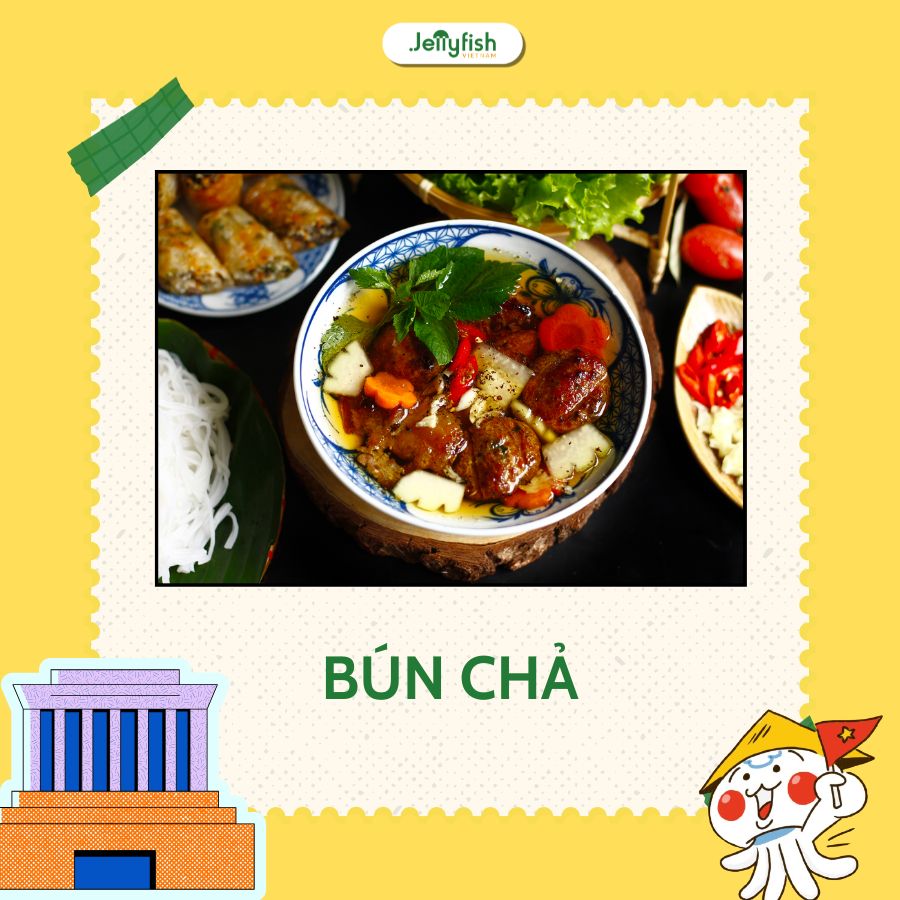If you ask a local in Hanoi what dish best represents the soul of the city, many will say bun cha. This beloved specialty combines smoky grilled pork, delicate rice noodles, and fragrant herbs in a perfect balance of sweet, savory, and fresh flavors. As a cornerstone of bun cha Vietnamese street food, it’s not just a meal — it’s an experience. In this article, Jellyfish takes you on a flavorful journey through the history, preparation, and cultural significance of bun cha in Vietnam.
1. What Is Bun Cha?
Bun cha is a traditional Vietnamese street food dish that originated in Hanoi. It consists of:
- Grilled pork (chả): There are usually two kinds — grilled pork patties and slices of pork belly
- Rice vermicelli noodles (bún): Served cold or at room temperature
- Fresh herbs: Lettuce, mint, perilla, coriander
- Pickled vegetables: Green papaya or carrot slices
- Dipping sauce: A sweet-sour mix of fish sauce, sugar, vinegar, and garlic, often served warm
Everything is served separately, allowing diners to mix each bite just how they like. This customizable style is part of what makes bun cha Vietnamese street food so beloved.

2. The Origin of Bun Cha in Vietnamese Street Culture
Bun cha is believed to have originated in Hanoi, and it remains a signature dish of the capital. It was first recorded in a 1959 Hanoi food review and has since become one of the city’s most iconic street foods.
- Typically served during lunchtime only (11 AM to 2 PM)
- Sold from both open-air street stalls and casual family-run restaurants
- Popular among office workers, students, and tourists alike
Street vendors grill pork over open charcoal fires right on the sidewalk, giving off a smoky aroma that signals it’s time for a bun cha break.
3. What Makes Bun Cha Vietnamese Street Food Special?
Unlike phở or bánh mì, which are known nationwide, bun cha is very Hanoi-specific in its style and flavor. Here’s what makes it special:
- Smoky grilling: Charcoal-grilled pork gives the dish its signature flavor
- Balanced dipping sauce: Sweet, tangy, salty — all in harmony
- Fresh and light: No heavy sauces, just fresh herbs and bright flavor
- DIY eating: You get to assemble each bite with noodles, herbs, pork, and sauce
These traits make bun cha Vietnamese street food both unique and endlessly satisfying.
4. The Obama Bun Cha Moment
Bun cha received international fame in 2016 when U.S. President Barack Obama dined at a modest Hanoi bun cha restaurant with chef Anthony Bourdain.
- They sat on plastic stools and shared beer and bun cha — just like locals
- The visit highlighted how bun cha is authentic, approachable, and cultural
- Since then, bun cha has become a bucket-list food experience for many travelers
This moment also reminded the world that the best Vietnamese street food doesn’t come from fancy restaurants — it comes from the sidewalk.

5. How to Eat Bun Cha Like a Local
There’s no strict way to enjoy bun cha Vietnamese street food, but here’s how most locals eat it:
- Add noodles to your dipping sauce bowl, then top with herbs and pork
- Use chopsticks to pick up a bit of each for the perfect bite
- Don’t forget the pickled veggies — they add crunch and balance
- Optional: Enjoy with a side of fried spring rolls (nem rán)
The mix of smoky meat, refreshing herbs, and tangy sauce makes each bite different and exciting.
6. Where to Try the Best Bun Cha in Vietnam
If you’re visiting Vietnam and want to try authentic bun cha, here are some top spots:
- Bún Chả Hương Liên (Obama Bun Cha) – Hanoi
- Bún Chả Đắc Kim (Hang Manh Street) – Hanoi
- Bún Chả Tuyết (Nguyen Du Street) – Hanoi
- Local markets and street stalls – Nearly every neighborhood has its go-to vendor
Outside Hanoi, bun cha is less common but still available in many Vietnamese restaurants, especially those that specialize in northern cuisine.
7. Can You Make Bun Cha at Home?
Yes! While nothing beats the real deal on a Hanoi sidewalk, you can recreate bun cha Vietnamese street food at home with a few key ingredients:
- Marinate pork in fish sauce, sugar, garlic, and pepper
- Grill or pan-sear the pork until caramelized
- Serve with rice vermicelli, herbs, and a homemade dipping sauce
- Pickle veggies ahead of time for an authentic touch
Many Vietnamese families enjoy homemade bun cha as a weekend treat — easy to prepare, fun to eat.
Explore more: Vietnamese culture food in Ha Noi
Conclusion
Bun cha Vietnamese street food is a shining example of what makes Vietnam’s culinary scene so beloved — it’s flavorful, fresh, and deeply connected to place and tradition. With its balance of grilled meat, noodles, and herbs, bun cha is more than just a meal — it’s Hanoi on a plate.
Explore More Vietnamese Culture With Jellyfish
Interested in learning more about the culture behind the food? At Jellyfish, we offer Vietnamese language and culture courses designed to help you understand local life — from meals to manners.
- Learn how to order food like a local
- Understand Vietnamese ingredients, phrases, and customs
- Join flexible online or in-person classes with native instructors
Please leave your information via the registration form, we will contact you!
👉👉 Learning Vietnamese – Jellyfish Vietnam
✦ Hotline: 096 110 6466
✦ Head office: 1st Floor, Web3 Tower Building, Alley 4 Duy Tan Street, Cau Giay District, Hanoi
✦ Branch office: 2rd Floor, SH5.11 Vinhomes Marina, Vinh Niem, Le Chan, Haiphong
✦ Head office in Japan: 4F Westhill Building, Nishigotanda 2-24-4, Shinagawa, Tokyo, Japan


